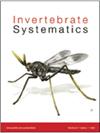Hidden in plain sight: Tripneustes kermadecensis (Echinodermata: Echinoidea) is a junior synonym of the eastern Australian sea urchin Evechinus australiae described in 1878
IF 1.9
2区 生物学
Q3 EVOLUTIONARY BIOLOGY
引用次数: 0
Abstract
Accurate taxonomy and descriptions of species are key to understanding biodiversity. The echinoid genus Tripneustes is an ecologically and commercially important taxon that includes the tropical Tripneustes gratilla gratilla and the recently described T. kermadecensis from Australia and New Zealand. While examining the Australian Museum collections to clarify the distributions of these two species in eastern Australia we found potential senior type material for T. kermadecensis. These specimens from Sydney Harbour were originally described in 1878 as Evechinus australiae by Tenison-Woods but neither illustrated nor redescribed in any subsequent report. We undertook molecular and morphological analysis of these specimens to determine whether T. kermadecensis and E. australiae represent two distinct taxa or not. This included micro-computed tomography, quantification of test traits and molecular genetic analysis. The COI sequence and morphology of Evechinus australiae matched that of Tripneustes kermadecensis. As such, T. kermadecensis is a junior synonym of Evechinus australiae. The correct designation of this taxon is therefore Tripneustes australiae (Tenison-Woods, 1878). ZooBank: urn:lsid:zoobank.org:pub:9B9E685C‐9C1C‐4645‐A799‐D97969BAA033隐藏在显眼的地方:Tripneustes kermadecensis(棘皮科:棘皮总科)是1878年发现的东澳大利亚海胆Evechinus australiae的初级同义种
准确的物种分类和描述是了解生物多样性的关键。棘虫属(Tripneustes)是一个重要的生态和商业分类群,包括热带棘虫属(Tripneustes gratilla gratilla)和最近发现的澳大利亚和新西兰的棘虫属(T. kermadecensis)。在检查澳大利亚博物馆藏品以澄清这两个物种在澳大利亚东部的分布时,我们发现了潜在的kermadecensis高级类型材料。这些来自悉尼港的标本最初在1878年被Tenison-Woods描述为澳大利亚Evechinus,但在随后的任何报告中都没有插图或重新描述。我们对这些标本进行了分子和形态学分析,以确定kermadecensis和australiae是否代表两个不同的分类群。这包括微观计算机断层扫描,测试特征的量化和分子遗传分析。澳大利亚Evechinus的COI序列和形态与kermadecensis相匹配。因此,T. kermadecensis是澳大利亚Evechinus的初级同义词。因此,这个分类群的正确名称是澳大利亚Tripneustes (Tenison-Woods, 1878)。ZooBank: urn: lsid zoobank.org:酒吧:9 b9e685c还是9 c1c量4645 A799 D97969BAA033应承担的
本文章由计算机程序翻译,如有差异,请以英文原文为准。
求助全文
约1分钟内获得全文
求助全文
来源期刊

Invertebrate Systematics
生物-动物学
CiteScore
4.30
自引率
9.10%
发文量
35
审稿时长
>12 weeks
期刊介绍:
Invertebrate Systematics (formerly known as Invertebrate Taxonomy) is an international journal publishing original and significant contributions on the systematics, phylogeny and biogeography of all invertebrate taxa. Articles in the journal provide comprehensive treatments of clearly defined taxonomic groups, often emphasising their biodiversity patterns and/or biological aspects. The journal also includes contributions on the systematics of selected species that are of particular conservation, economic, medical or veterinary importance.
Invertebrate Systematics is a vital resource globally for scientists, students, conservation biologists, environmental consultants and government policy advisors who are interested in terrestrial, freshwater and marine systems.
Invertebrate Systematics is published with the endorsement of the Commonwealth Scientific and Industrial Research Organisation (CSIRO) and the Australian Academy of Science.
 求助内容:
求助内容: 应助结果提醒方式:
应助结果提醒方式:


